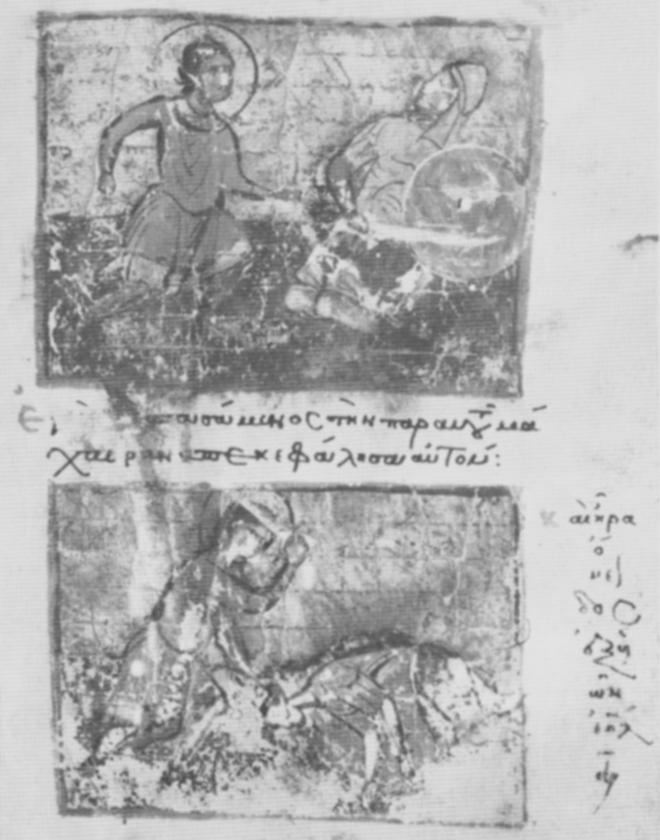
Try Amazon Fresh
Byzantine Psalter, manuscript Benaki 34.3, 14th century
David and Goliath

Fig. 7 F. 174r David’s battle with Goliath (Ps. 151).


The Psalter Benaki 34.3. An unpublished illuminated manuscript from the family 2400
Anthony Cutler, Annemarie Weyl Carr
p. 283
Benaki Vitr. 34.3 is a small codex of 198 folios and 49 gatherings, its 14.8 x 11.4 cm dimensions sitting easily in the hand. It is written in black ink with magenta capitals in twenty-four lines to the page. The script is a diminutive minuscule, disposed in a single column, pendant from the lines and using thirty to thirty-two letters per line.
…
p. 289
F. 174r offers two images representing discrete but closely related moments in David’s struggle with Goliath, separated by the last verse of Ps. 151 which ends in the lower right margin (fig. 7) 43.
A division of this scene into two registers is far from uncommon in Psalter illumination : Dumbarton Oaks 344, the former Berlin, Christlich-Archäologische Universitätsammlung 380745, now missing, Florence, Laur. 6.3646, the Spencer Psalter47, Oxford, Bodl. Barocci 1548, and Cambridge, Harvard College Lib. gr. 349, all distinguish in this fashion the battle under way from the battle won. Numerous others combine the two scenes within a single frame50. Few of these examples are as brilliantly coloured as the Benaki miniatures which set David, in a red tunic with gold collar and hem, and Goliath, in a gold breastplate over a short blue tunic, against each other on a green ground. More important, no other Psalter - and indeed no other Byzantine work known to us - displays the moment represented in the upper frame. Here the giant is approached by the running shepherd, his spear spent and sinking to his knees when struck by David’s stone.
Before we can decide whether the scene is an invention of the Benaki Master, it would be well to consider the lower miniature. Images of the decapitation are legion and Weitzmann has distinguished between two fundamental types : those in which the giant lies upon his back (which he believes to be ‘closer to the archetype’) as against those in which Goliath kneels in the attitude of a Christian martyr51. The majority of Psalter
43. The unusual format of this page and the ‘spillage’ of text into the margin indicate that at least these miniatures were painted before the scribe’s duty was completed.
44. F. 71r : S. DER NERSESSIAN, A Psalter and New Testament Manuscript at Dumbarton Oaks, DOP 19, 1965, fig. 8.
45. F. 231r : G. STUHLFAUTH, A Greek Psalter with Byzantine Miniatures, Art Bulletin 15, 1933, fig. 13.
46. F. 347r (unpublished). Cf. ROSTAGNO-FESTA, Indice (note 37, supra).
47. F. 363v : A. CUTLER, Spencer Psalter (note 18, supra), fig. 11.
48. F. 343r : K. WEITZMANN, Prolegomena to a Study of the Cyprus Plates, Metropolitan Museum Journal 3, 1970, fig. 8.
49. F. 215v (unpublished). Cf. Illuminated Greek Manuscripts from American Collections, Princeton 1973, n° 32. We await a fuller study of this manuscript by Lawrence Nees, due to appear in DOP.
50. Paris, B.N. gr. 139, f. 4v : H. BUCHTHAL, The Miniatures of the Paris Psalter, London 1938, fig. 4 ; Athos, Vatopedi 760, f. 264r : WEITZMANN, Prolegomena (note 48, supra), fig. 19 ; British Museum, Add. 40753, f. 145v (unpublished). Cf. note 32, supra.
51. K. WEITZMANN, Vatopedi 761 (note 14, supra), p. 41-42, 46 ; IDEM, Prolegomena (note 48, supra), p. 103-106.
p. 290
illustrations of this second type show David in the act of applying the sword to the Philistine’s neck52. But our scene shows the giant on ‘all fours’, still helmeted but with his shield beneath him, awaiting the descent of the blade yet raised above the shepherd’s right shoulder. This frozen moment before the execution occurs in the third-century wall-painting in the Christian Building at Dura-Europos (where Goliath lies upon his back) 53. But in manuscript illumination it is found only in a Psalter which we have already had several occasions to cite : British Museum, Add. 4075354. Even though the miniature in London is awkwardly composed - David stands by the giant’s feet preparing to behead him with a backstroke - in light of this and of the late antique fresco, we cannot assume that our rare scene originated in the Psalter in Athens. Indeed, the evidence of copying elsewhere in the manuscript would argue strongly against such an assumption. The fact remains, nonetheless, that no parallel to the upper miniature exists. If these scenes are borrowed, then they derive from some iconographical tradition unknown to us55.
52. K. WEITZMANN, Prolegomena (note 48, supra), fig. 8, 9.
53. Ibid., fig. 7 ; Ch. Kraeling, The Christian Building. The Excavations at Dura Europos, Final Report, VIII, 2, New Haven 1967, p. 69-71, pl. XLI, 2.
54. F. 145v (unpublished. Cf. note 32, supra). One of the illustrations to this psalm in a Bulgarian work of the second half of the fourteenth century, shows David in the act of raising (or lowering) his sword above the prone Goliath while three soldiers hurry away to the right : M. V. SHEPKINA, Bolgarskaia miniatiura XIV veka. Issledovanie psaltyri Tomicha, Moscow 1963, n° 66, pl. IV.
55. While the text of I Reg. 17,50 could have inspired an artist to render Goliath’s collapse, the subject of our upper miniature, and while the subsequent verse does not exclude an interpretation as in the lower, it should be noted that the only surviving Book of Kings, Vat. gr. 333, shows the conventional scene of Goliath hurling his spear for the first incident (f. 23v) and the ‘martyr-like’ decapitation in its successor (f. 24r). Cf. J. LASSUS, L’illustration byzantine du Livre des Rois (Bibliothèque des Cahiers Archéologiques 9), Paris 1973, nos 42, 43a.
Source: Persee.